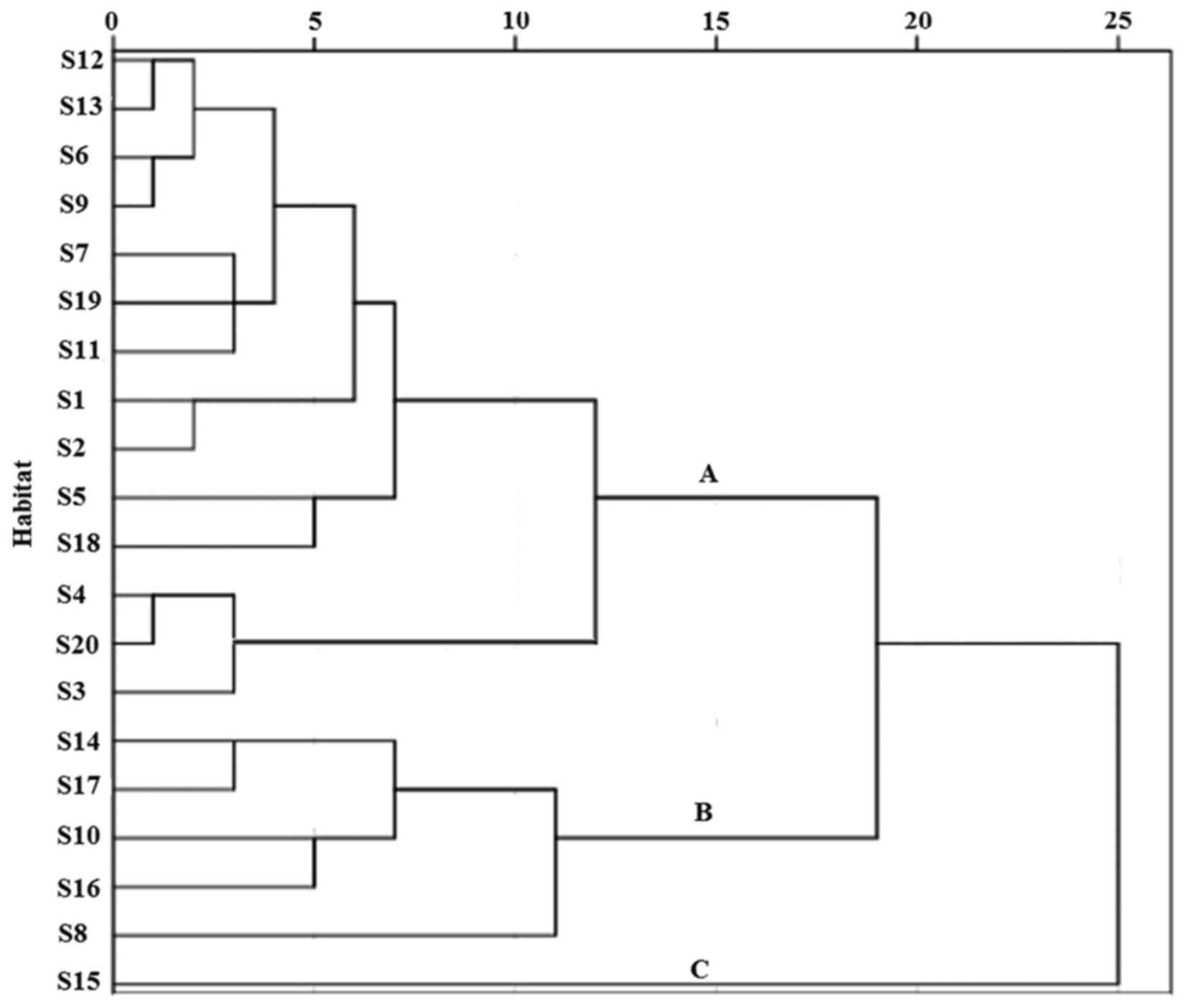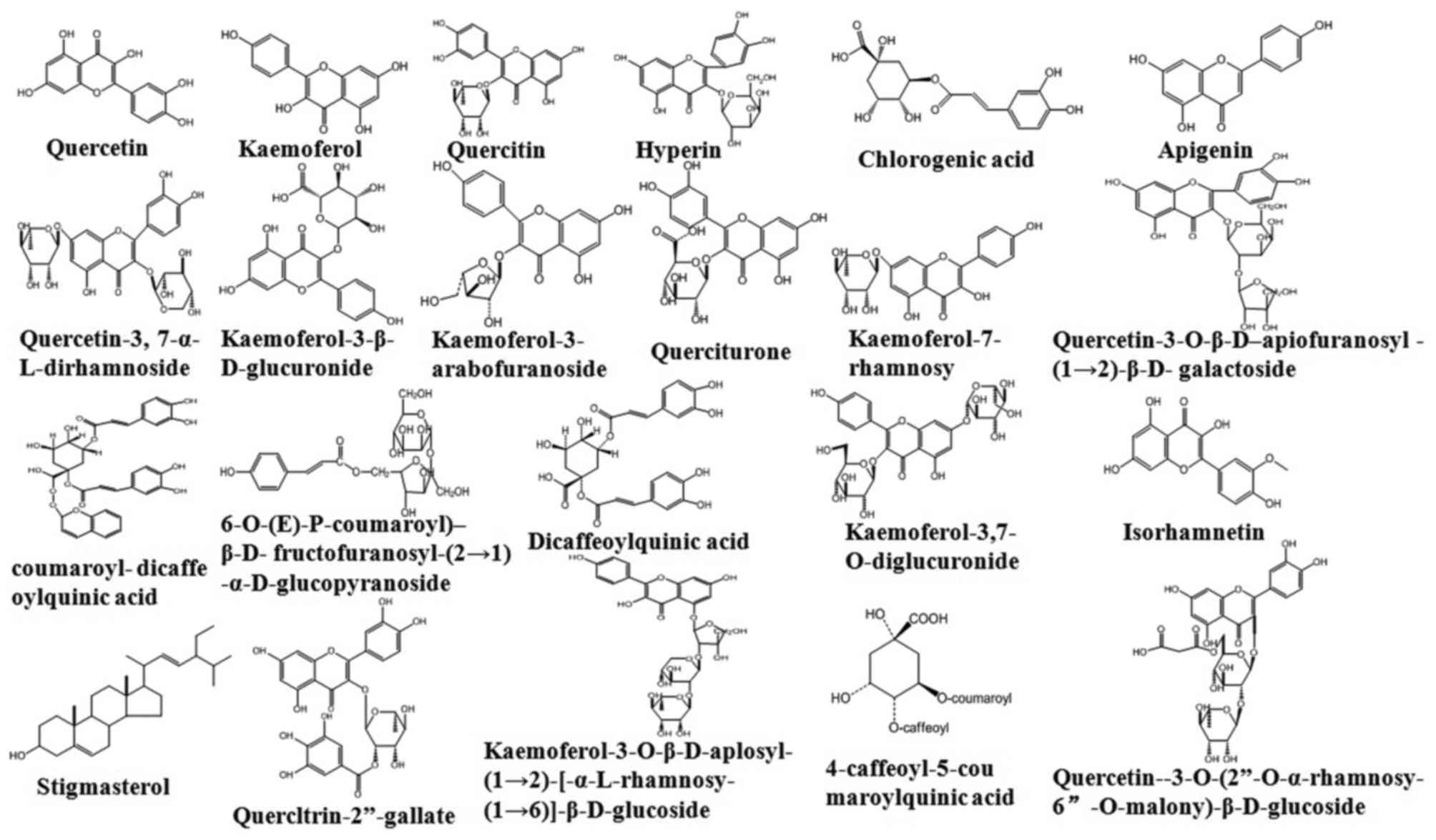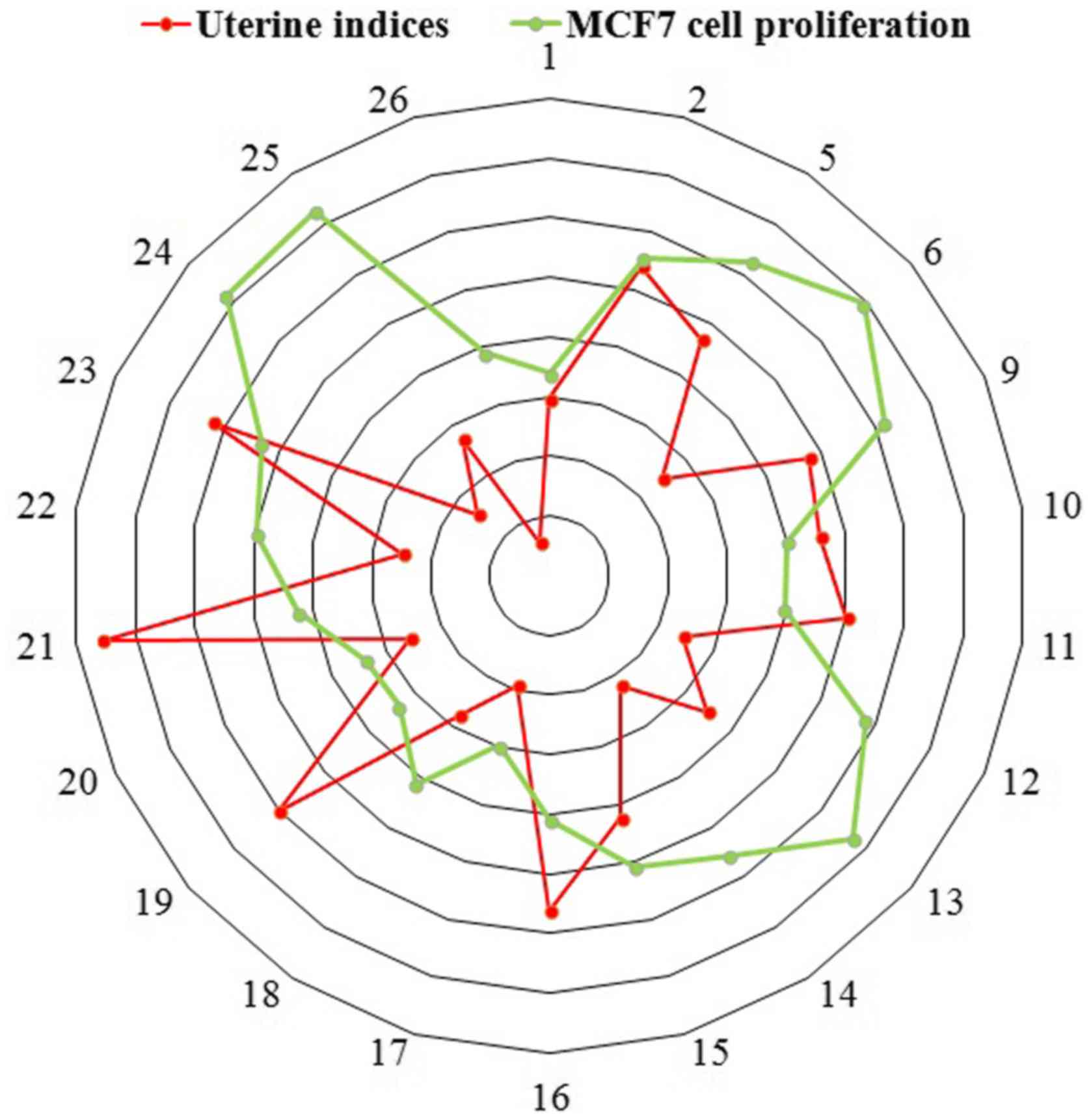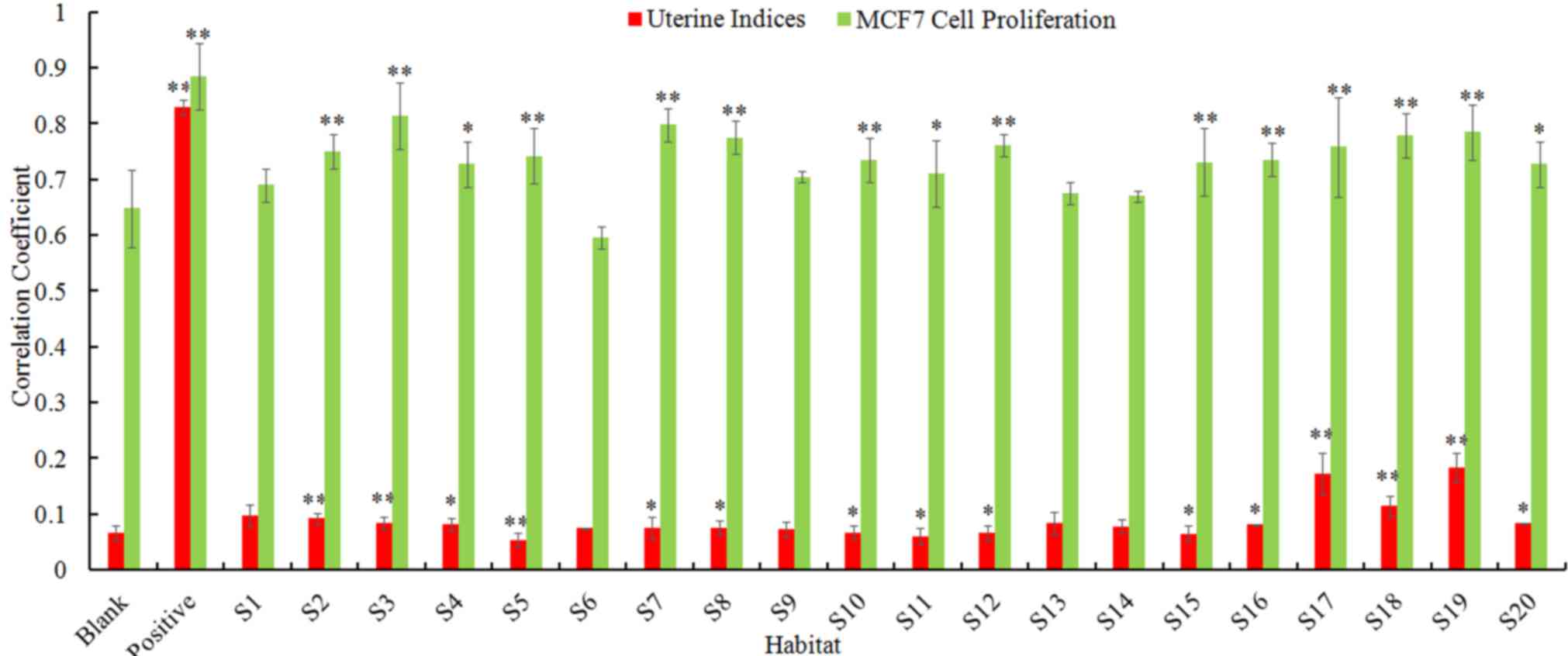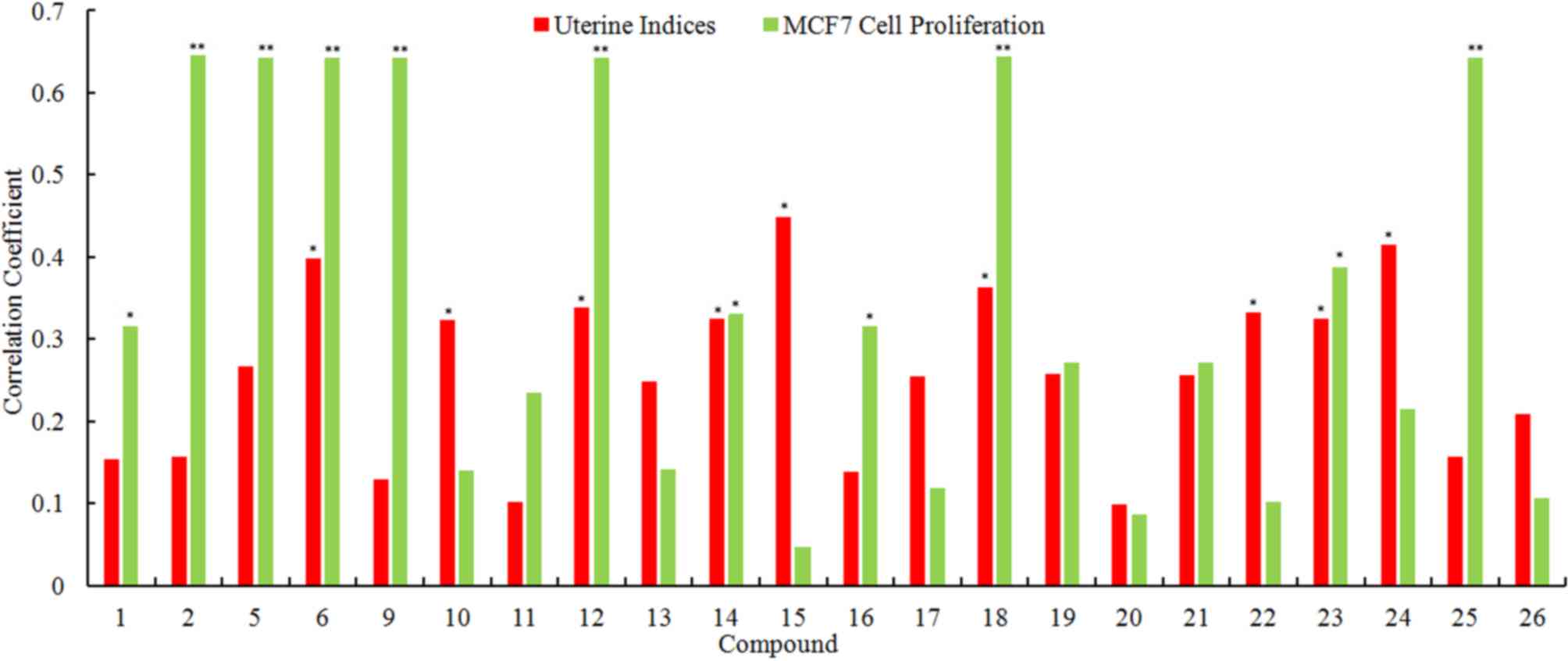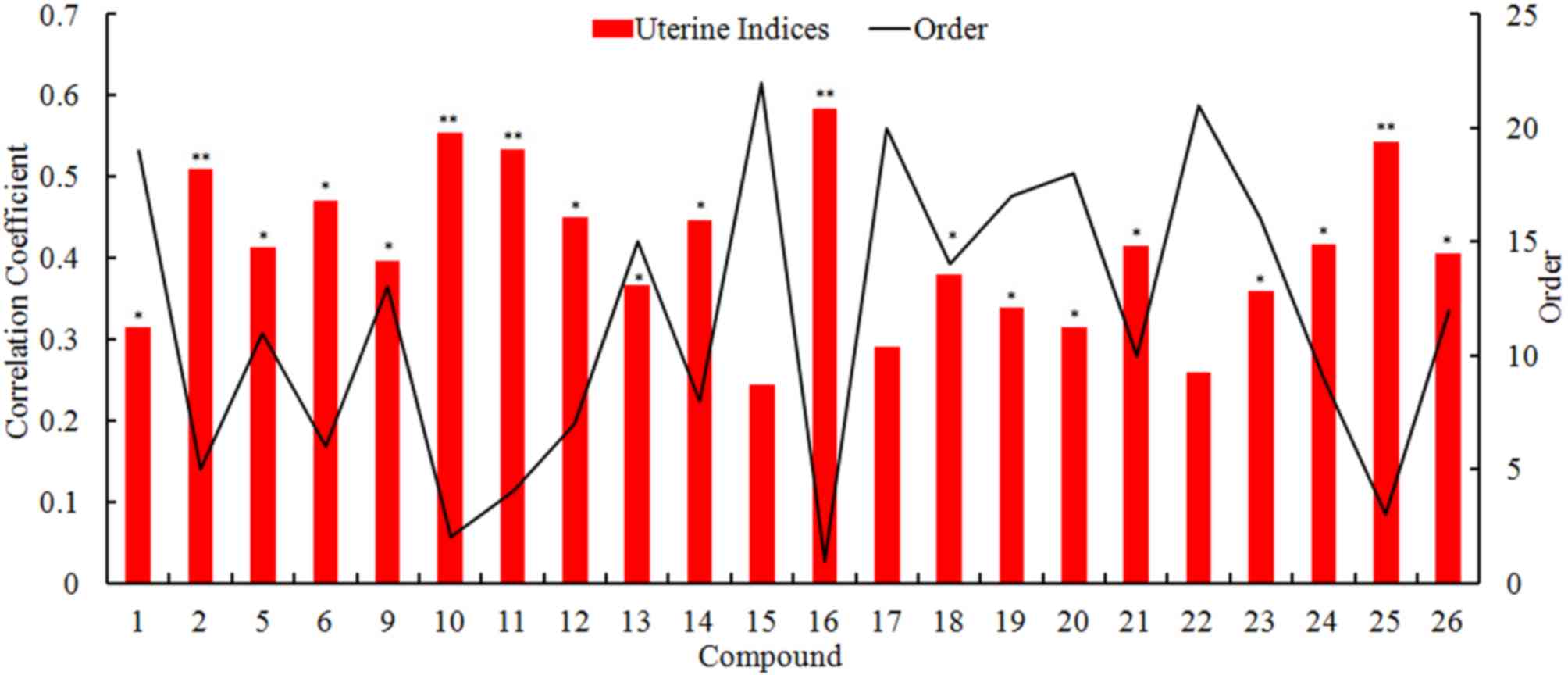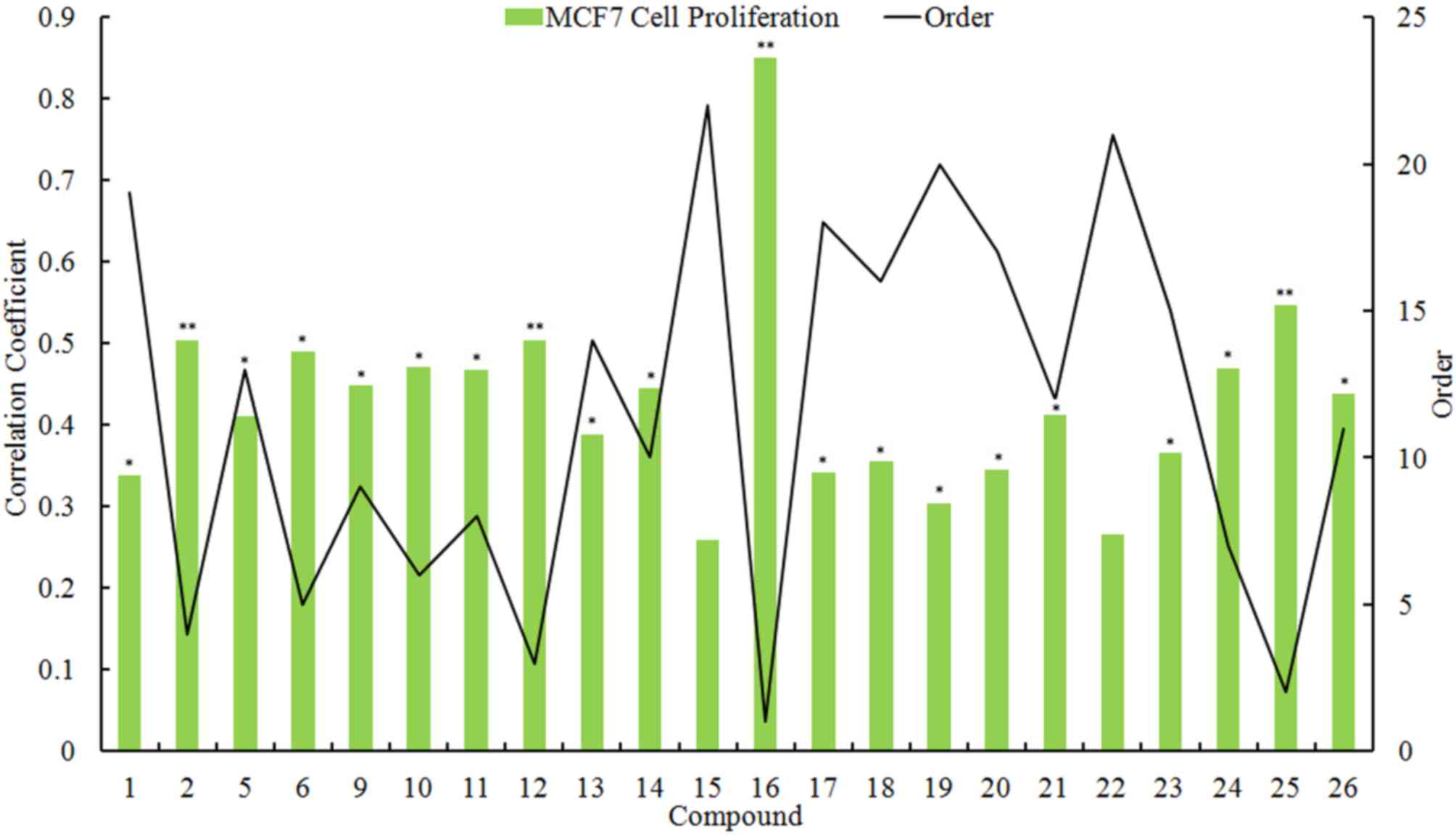Characterization of estrogenic active ingredients in Cuscuta chinensis Lam. based on spectral characteristics and high‑performance liquid chromatography/quadrupole time‑of‑flight mass spectrometry
- Authors:
- Published online on: December 12, 2018 https://doi.org/10.3892/mmr.2018.9755
- Pages: 1238-1247
Abstract
Introduction
More people are now paying serious attention to personal and non-visible health problems. For many modern women, the menopausal syndrome seriously affects their quality of life. In addition, diseases such as breast cancer, endometrial cancer and osteoporosis, among others, occur frequently; therefore, there is an urgent need to identify methods that prevent and/or control their occurrence. In China, traditional Chinese medicine (TCM) is often used to prevent and treat these diseases. Phytoestrogens (PEs), which are derived from plant ingredients, can be activated and combined with human estrogen receptors, as the structures of PEs are similar to that of endogenous estrogen in mammals and humans; therefore, using PEs to mimic the role of estrogen may facilitate the prevention and control of specific diseases. In addition, the use of estrogen for hormone therapy has extensive side effects that cannot be ignored, rendering the cost-benefit of this approach debatable. Therefore, it is imperative to investigate whether certain TCM compounds that contain PEs may be used as hormone replacement therapy (1,2), and to characterize their efficiency and toxicity profiles relative to those of standard hormone therapy. It is necessary to develop and fully characterize these alternative derivative drugs, in order to generate the most effective compositions for use in subsequent clinical applications (3–6).
The complexity of TCM arises from its multi-system, multi-target, multi-channel pharmacodynamics and treatment characteristics. Some previous studies have focused on the effects of estrogen and its mechanism of action (7,8). Notably, the actual effect of TCM depends on the correlation between its chemical constituents and its components with pharmacological activity (8). In addition, clarifying the overall efficacy and function of TCM is central to ensuring drug safety and quality control.
In recent years, the spectrum-effect relationship model has been used to investigate the correlation between the chromatographic fingerprint of a TCM drug and its pharmacodynamic effects. Firstly, chromatogram characteristic absorption peaks are obtained and recorded via liquid chromatography (LC). Secondly, these are combined with pharmacological indices to evaluate efficacy. Finally, mass spectrometry (MS) is used to qualitatively characterize the ingredients and reveal the active substances. The relationship between the chemical constituents and pharmacological activity of a TCM drug is used to assess whether its efficacy and material basis is consistent with its functional characteristics. This relationship is then used to identify the active components in a TCM drug, to formulate control standards and to reflect the internal quality of the drug. The spectrum-effect relationship has been applied in various areas, including assessing pharmaceutical/chemical material basis, identifying active ingredient combinations, and in technology optimization (9–11). In addition, it is used for the optimization of novel formulae, the tracking and separation of target ingredients, and the development of novel drugs (12–15).
Cuscuta chinensis Lam. is a type of edible TCM. It was initially recorded in Shen Nong's Herbal, and was listed as a top-grade herb (16). From its extract, various chemical constituents have been separated and identified, including flavonoids, glycosides, trace elements, amino acids, coumarins, alkaloids, tannic acids and triterpene acids (17,18). Cuscuta chinensis Lam. is commonly used to support the normal functions of the liver and kidneys, strengthen muscles and bones, and exert anti-osteoporotic and antioxidant activities (19–21). Based on preliminary experiments, this extract has been confirmed to possess significant estrogenic activity (16). The chemical spectra of Cuscuta chinensis Lam. samples obtained from various regions have been recorded using high-performance LC (HPLC) (22,23). In the present study, the estrogenic activity of Cuscuta chinensis Lam. was assessed using a uterus growth test and an MTT assay. The comprehensive results of bivariate, principal component and Gray relational analyses indicated several active compounds of Cuscuta chinensis Lam. that may be further investigated in future studies. This study provided a theoretical basis for the material efficacy of Cuscuta chinensis Lam., and laid the foundation for its further development and clinical application.
Materials and methods
Instrumentation, animals and reagents
Agilent 1290 HPLC system, Agilent 6530 Series Quadrupole Time-of-Flight (Q-TOF) LC/MS system (Agilent Technologies, Inc., Santa Clara, CA, USA) and Chemical HPLC-3D workstations (Agilent Technologies, Inc.) were used for analytical chemistry and data processing. Milli-Q ultrapure water (Merck KGaA, Darmstadt, Germany) was used for preparation of samples and standards. Additional instruments included the electronic analytical balance AR1140 (Ohaus Corporation, Parsippany, NJ, USA), 680 Microplate Reader (Bio-Rad Laboratories, Inc., Hercules, CA, USA) and Allegra 64R High-Speed Centrifuge (Beckman Coulter, Inc., Brea, CA, USA).
Immature female Kunming mice (~21 days old, weaned, n=220), weighing 12±2 g, were purchased from Changchun National Biological Industry Base Laboratory Animal Center [SCXK-(China) 2003–0004; Changchun, China]. The mice were divided into 22 groups (n=10/group) and housed in a temperature-regulated room (22±2°C) with humidity 60±10% and unrestricted access to food and water.
Cuscuta chinensis Lam. was purchased from San Keshu Chinese Herbal Medicine Market (Harbin, China) and was identified by Prof. Zhang Delian (Harbin University of Commerce, Harbin, China). The samples of C. chinensis had been collected from 20 diverse habitats, namely Shuangyashan (site 2012011501; Zongyi Medicine Station, Harbin, China), Qingdao (site 2012011502; Anguoyutai Medicine Station, Harbin, China), Dezhou (site 2012011503; Jingtai Medicine Station, Harbin, China), Hulin (site 2012011504; Longfukang Medicine Station, Harbin, China), Liaoning (site 2012011505; Guangyuan Medicine Station, Harbin, China), Shanxi (site 2012011506; Beiguo Medicine Station, Harbin, China), Shanghai (site 2012011507; Wanbei Medicine Station, Harbin, China), Jiangsu (site 2012011508; Renhetang Medicine Station, Harbin, China), Anhui (site 2012011509; Chaoyang Medicine Station, Harbin, China), Zhejiang (site 2012011510; Zhonglian Medicine Station, Harbin, China), Nanning (site 2012011511; Qiancao Medicine Station, Harbin, China), Shaanxi (site 2012011512; Dushitang Medicine Station, Harbin, China), Guangdong (site 2012011513; Ruixintang Medicine Station, Harbin, China), Beihai (site 2012011514; Hongtai Medicine Station, Harbin, China), Henan (site 2012011515; Yixintang Medicine Station, Harbin, China), Hebei (2012011516, Xinhe Medicine Station, Harbin, China), Alashan (site 2012011517; Taida Medicine Station, Harbin, China), Neimeng (site 2012011518; Longyuan Medicine Station, Harbin, China), Sichuan (site 2012011519; Tianran Medicine Station, Harbin, China) and Ningxia (site 2012011520; Anjiang Medicine Station, Harbin, China). Diethylstilbestrol was purchased from Hefei Jiulian Pharmaceutical Co., Ltd. (Hefei, China). RPMI 1640 and RPMI 1640 without phenol red were purchased from HyClone; GE Healthcare (Logan, UT, USA). MTT and dimethyl sulfoxide (DMSO) were purchased from Sigma-Aldrich; Merck KGaA. The MCF7 human breast cancer cell line was provided by the Research Center of the Life and Environmental Sciences, Harbin University of Commerce. The standards used were chlorogenic acid, hyperin, quercitin, kaempferol and quercetin, which were obtained from the National Institute for the Control of Pharmaceutical and Biological Products (Beijing, China). The purity of each standard was ≥98%. Acetonitrile, methanol and formic acid were of MS-grade and water was ultrapure. Other reagents were of analytical grade and were commercially available.
Preparation of the sample solution
A solution of the Cuscuta chinensis Lam. (1.0 g/ml) was prepared in distilled water for oral administration. The positive control solution consisted of 20 µg/ml diethylstilboestrol in distilled water. The solution (0.1 g/ml) of Cuscuta chinensis Lam. was prepared in 80% methanol. Chlorogenic acid, hyperin, quercitin, kaempferol and quercetin (2.0 mg each) were dissolved in 10 ml 80% methanol solution. The sample and standard solutions were filtered using a 0.45-µm filter prior to analysis.
LC-MS conditions
A Waters Symmetry Shield RP18 (4.6×250 mm, 5 µm; Waters Corporation, Milford, MA, USA) was used to analyze the samples. The mobile phase consisted of methanol (A) and 0.2% (v/v) formic acid aqueous solution (B), and was pumped at a flow rate of 0.5 ml/min. The injection volume of each sample was 10 µl. The gradient elution program was as follows: Mobile phase A was initiated at 21% and increased linearly to 29% at 30 min. Solution A was subsequently increased to 36% (30–50 min), 38% (50–65 min), 44% (65–90 min) and 65% (90–125 min). The mobile phase A was then decreased to 21% for the last 5 min of the run (125–130 min). The column temperature was maintained at 30°C. The chromatograms were monitored at 328 nm. The atomization gas pressure was 0.25 MPa, and the capillary voltage was 8 kV. The flow rate of the dry gas was set to 8.0 l/min with the temperature at 30°C. The temperature of the sheath gas was set at 400°C, and its flow rate was 34.0 l/min. The collision energy was set to 10–30 eV. The mass spectra were recorded within the scan range between 100 and 1,700 Da, and were in negative ion scanning mode.
Fingerprint evaluation
LC fingerprints of the samples collected from 10 different batches of Cuscuta chinensis Lam. were established, and matched automatically using the Similarity Evaluation System for Chromatographic Fingerprint of TCM (version 2012; China Pharmacopoeia Committee, Beijing, China). Furthermore, the reference chromatogram map was generated using the median method. In addition, cluster analysis was applied to evaluate the quality of the samples from 20 diverse habitats.
Principal component analysis (PCA)
PCA is a widely used multivariate statistical method. In the present study, characteristic peaks from the LC chromatograms were further screened by PCA, with the aim of identifying active compounds based on spectrum-effect relationship.
Uterus growth test
The mice were divided into 22 groups (n=10/group). The sample solutions that were prepared from Cuscuta chinensis Lam. were administered twice daily (8 h were between administrations in the morning and evening) by oral gavage at a dose of 24 g/kg body weight for 4 days. In our previous study, four different doses (3, 6, 12 and 24 g/kg) were administered, in order to evaluate the efficacy of the drug; finally, 24 g/kg was determined to be the effective dose (24). The blank and positive control groups comprised equal volumes of distilled water and diethylstilbestrol solution, respectively, which were also administered twice daily for 4 days. On day 5, drug-containing blood samples were obtained from the orbit of the anesthetized mice. The samples were centrifuged at 3,802 × g for 10 min at 4°C, and the supernatants (drug-containing serum samples) were collected. The drug-containing serum samples were inactivated by heating at 56°C in a water-bath for 30 min, and were filtered through a 0.22-µm filter prior to the MTT assay. The uteri of the mice were immediately excised and weighed following anaesthetization and decapitation, in order to calculate uterine weight indices. Animal experimentation was initiated following 5 days of acclimation. The mice were fasted overnight with free access to water prior to administration of the test solutions. The present study was conducted in strict accordance with the recommendations of the Guide for the Care and Use of Laboratory Animals of the National Institutes of Health (25). All experimental procedures were reviewed and approved by the Animal Ethical Committee of the Harbin University of Commerce. All potentially stressful procedures were performed under sodium pentobarbital anesthesia. Pentobarbital sodium was prepared to 1% of the concentration, with an i.p. injection dose of 40 mg/kg. If the anesthetic effect was not appropriate, 10 mg/kg was supplemented after 20 min.
MTT assay
MCF7 cells were co-cultured in RPMI 1640 without phenol red containing 5% charcoal-dextran-treated fetal bovine serum (HyClone; GE Healthcare Life Sciences) for 4 days in an incubator containing 5% CO2 at 37°C. The cells were seeded in 96-well plates at a density of 2,000 cells/well. An adherent culture was achieved and after 72 h of culture, the cells were co-cultured in RPMI 1640 medium containing 10% serum samples from Cuscuta chinensis Lam.-treated mice. The experiments were conducted in 6 replicates. Subsequently, 20 µl MTT solution (5 mg/ml in PBS) was added to each well, and the cells were incubated for 4 h at 37°C. After the removal of medium, 150 µl DMSO was added, in order to dissolve the formazan crystals, and the plates were agitated in the dark for 15 min at room temperature. The absorbance was measured at 570 nm using a microplate reader. The proliferation rate was calculated as the average absorbance value of the drug-containing serum group divided by the average absorbance value of the blank control group (cells cultured in RPMI 1640 without serum).
Statistical analysis
Paired-sample t-test (two-tailed) and one-way analysis of variance followed by Tukey's test were used to identify statistically significant differences among values in the blank control and experimental groups. P<0.05 was considered to indicate a statistically significant difference. The results of the aforementioned analytical methods were consistent.
Pearson's correlation coefficient was used to calculate the relative peak areas, which corresponded to estrogenic activity of the samples. Correlation coefficients >0.3 were considered significant (P<0.05), whereas correlation coefficients >0.5 were considered highly significantly (P<0.01).
PCA was used to evaluate characteristic peak areas in the chromatograms of the samples from 20 diverse habitats. Bivariate analysis and Grey relational analysis were used to assess the correlation of peak areas and their estrogenic activity. Paired-sample t-test (two-tailed), ANOVA followed by Tukey's test and bivariate analysis were conducted using SPSS software (SPSS for Windows 21.0; IBM Corporation, Armonk, NY, USA). Grey relational analysis was calculated using DPS version 8.0 (Fiberhome Telecommunication Technologies Co., Ltd., Wuhan, China). P<0.05 was considered to indicate a statistically significant difference.
Results and Discussion
Cluster analysis and similarity assessment
The relative standard deviation of the retention time and peak area of characteristic peaks were 0.77 and 0.62% for precision, 0.52 and 0.14% for reproducibility, and 0.95 and 0.85% for stability, respectively. These results indicated that the established LC fingerprinting method was feasible. The similarities of the chromatograms from 10 different batches of Cuscuta chinensis Lam. from the same habitat were all >0.9. Perhaps be due to the limitation of the instrument hardware, or since the content cannot reach the detection limit, the chromatographic peaks for all samples may not fully represent the characteristic constituents of Cuscuta chinensis Lam. as peaks could possibly been lost. Therefore, the sample matching number of peaks analyzed was adjusted from 26 to 22, in order to obtain a more accurate chromatogram map. A total of 26 peaks were obtained, and the sum of their areas was >0.8 compared with those of the overall peak area in the sample (the sum of the areas is the sum of 26 characteristic peak areas. The overall peak area is the area of all peaks in the chromatogram). Therefore, it was concluded that these chromatographic peaks could effectively reflect the main active constituents of Cuscuta chinensis Lam. The results of cluster analysis are shown in Fig. 1. A total of 20 diverse habitats were divided into three categories as follows: A: S12, Shaanxi; S13, Guangdong; S6, Shanxi; S9, Anhui; S7, Shanghai; S19, Sichuan; S11, Nanning; S1, Shuangyashan; S2, Qingdao; and S5, Liaoning; B: S18, Neimeng; S4, Hulin; S20, Ningxia; S3, Dezhou; S14, Beihai; S17, Alashan; S10, Zhejiang; S16, Hebei; and S8, Jiangsu; and C: S15, Henan.
Identification of chemical constituents
Active ingredients were orally administered in the form of mixtures rather than monomers, because TCM exerts its pharmacological effects based on the synergy between components. Conversely, individually separated single compounds may not exert therapeutic effects (7,8). Previous studies have been conducted to identify the chemical compounds of Cuscuta chinensis Lam. (22,23). The correlation between inherent constituents and their activities indicated that they could be identified based on the combination of LC with the corresponding indices of pharmacological activity. Q-TOF-MS is widely used for constituent identification of TCM, since it can provide the exact molecular mass. By analyzing the primary and secondary MS data, 26 compounds were identified. The present study aimed to reveal compounds that have estrogenic activity among the known components of Cuscuta chinensis Lam.; therefore, nuclear magnetic resonance spectroscopy was not required to validate their identity. Based on the results of MS, mixtures of active ingredients were prepared and their estrogenic activity was validated, in order to determine the bioactive components with estrogenic activity of Cuscuta chinensis Lam. In addition, PCA was used to assess the size of contribution for these compounds with regards to their estrogenic activity. A contribution of the activity is indicated by an eigen value >1 and a cumulative contribution rate of variables >0.8. The higher the absolute value of the eigen load, the higher the influence of the compound on estrogenic indices.
The chromatograms of Cuscuta chinensis Lam. and the standard samples were compared in order to identify individual compounds under the same LC-MS conditions. As shown in Table I, 26 constituents were identified. Peak 1 indicated a predominant deprotonated ion with a m/z ratio of 695 (C30H32O19), which was identical to the elemental composition of quercetin-3-O-(2‘-O-α-rhamnosy-6’-O-malony)-β-D-glucoside. This was supported by the loss of a glucose moiety that yielded a fragment ion with a m/z ratio of 533, further supporting the initial prediction. Peak 2 indicated a predominant deprotonated ion with a m/z ratio of 725 (C32H38O19), which was identical to the elemental composition of kaempferol-3-O-β-D-aplosyl-(1→2)-[-α-L-rhamnosy-(1→6)]-β-D-glucoside, and was supported by the loss of a glucose moiety and a rhamnopyl moiety, forming a fragment ion with a m/z ratio of 359. Peak 5 demonstrated a predominant deprotonated ion with a m/z ratio of 487 (C22H16O13), which is identical to the elemental composition of 6-O-(E)-P-coumaroyl)-β-D-fructofuranosyl-(2→1)-α-D-glucopyranoside. The loss of a coumaryl moiety formed a fragment ion with a m/z ratio of 341, and was followed by a subsequent loss of an additional OH moiety to form a fragment ion with a m/z ratio of 325, which was in agreement with the aforementioned data. Peak 11 indicated a predominant deprotonated ion with a m/z ratio of 499 (C22H28O13), which was identical to the elemental composition of 4-caffeoyl-5-coumaroylquinic acid. The loss of a COOH moiety formed a fragment ion with a m/z ratio of 453. Peak 25 indicated a predominant deprotonated ion with a ratio m/z of 411 (C29H48O), which was identical to the elemental composition of stigmasterol. The loss of a CH3 moiety, forming a fragment ion with a ratio m/z of 397, further supported the inference. The retention time and MS/MS data, as well as the identification of 26 compounds are listed in Table I. The structures of 22 compounds are shown in Fig. 2.
PCA
As shown in Table II, the eigen values of the first 19 principal components were >1, and the cumulative contribution rate of the first six principal components was 85.447%. Therefore, the first six principal components were evaluated further. Table II indicates their eigen values and factor loadings. The first principal component exhibited higher load based on the eigen values of the eight peaks (>0.8). These peaks were the following: 2, 5, 8, 9, 10, 11, 13 and 20. The second principal component revealed only peak 22 had a load value >0.8. Consequently, kaempferol-3-O-β-D-aplosyl-(1→2)- [-α-L-rhamnosy-(1→6)]-β- D-glucoside, 6-O-(E)-P- coumaroyl) -β-D-fructofuranosyl-(2→1)- α-D-glucopyranoside, kaempfe-rol-3-β-D-glucuronide, apigenin, 4-caffeoyl-5-coumaroylquinic acid, quercetin-3-O-β-D-apiofuranosyl-(1→2)- β-D-galactoside, chlorogenic acid, quercetin, and one unknown compound, corresponding to a total of nine peaks were selected as representative variables, and their estrogenic activity was analyzed (Fig. 3).
Determination of estrogenic activity
The ratio of uterine wet weight to body weight of each mouse was calculated (Fig. 4). Animals exposed to Cuscuta chinensis Lam. from 15 habitats exhibited significant estrogenic activities by increasing uterine weight compared with mice in the blank control group. In addition the proliferation rate of MCF7 cells treated with serum from Cuscuta chinensis Lam.-treated mice was determined. Cells treated with sera from mice that were administered Cuscuta chinensis Lam. from 15 habitats exhibited significantly increased growth compared with cells devoid of treatment (Fig. 4).
Bivariate analysis
The present study revealed that the uterine weights of immature female Kunming mice were increased and the proliferation of MCF7 human breast cancer cells was promoted by some of the Cuscuta chinensis Lam. components. These findings confirmed the estrogenic activity of Cuscuta chinensis Lam. The uterine indices and MCF7 cell proliferation rates of these constituents are shown in Fig. 5. Pearson's correlation coefficient was used to calculate the relative peak areas, which corresponded to estrogenic activity of the samples. Correlation coefficients >0.3 were considered significant (P<0.05), whereas correlation coefficients >0.5 were considered highly significantly (P<0.01). Based on these results, Cuscuta chinensis Lam. was revealed to possess estrogenic activity. A total of nine compounds were significantly correlated with the increase in the uterine weight (P<0.05), whereas 11 compounds were significantly correlated with MCF7 cellular proliferation (P<0.05). The compounds that were significantly correlated with uterine weight and cell proliferation were quercetin-3-O-(2‘-O-α-rhamnosy-6’-O-malony)-β-D-glucoside, kaempferol-3-O-β-D-aplosyl-(1→2)-[-α-L-rhamnosy-(1→6)]-β-D-glucoside, 6-O-(E)-P-coumaroyl)- β-D-fructofuranosyl-(2→1)-α-D-glucopyranoside, kaempferol- 7-rhamnosy, kaempferol-3-β-D-glucuronide, apigenin, kaempferol-3-arabofuranoside, dicaffeoylquinic acid, hyperin, quercitin, isorhamnetin, quercetin, quercltrin-2″-gallate, quercetin-3, 7-α-L-dirhamnoside and stigmasterol (Fig. 5). These 15 compounds exerted estrogenic activities.
Gray relational analysis method
The relative correlation of the characteristic peaks of the 26 compounds with uterine indices is shown in Fig. 6, and the relative correlation of characteristic peaks of the 26 compounds with cell proliferation rates are shown in Fig. 7. The five compounds that exhibited the highest correlation with uterine indices were quercitin, apigenin, stigmasterol, 4-caffeoyl-5-coumaroylquinic acid and kaempferol-3-O-β-D-aplosyl-(1→2)-[-α-L-rhamnosy-(1→6)]- β-D-glucoside (Fig. 6, in descending order); whereas the five compounds that exhibited the highest correlation with MCF7 cell proliferation were quercitin, stigmasterol, kaempferol-3-arabofuranoside, kaempferol-3-O-β-D-aplosyl-(1→2)-[-α-L-rhamnosy-(1→6)]-β-D-glucoside and kaempferol-7-rhamnosy (Fig. 7, in descending order). The relative correlations of quercitin, apigenin, stigmasterol, 4-caffeoyl-5-coumaroylquinic acid, kaempferol-3-O-β-D-aplosyl-(1→2)-[-α-L-rhamnosy-(1→6)]-β-D-glucoside, kaempferol-3-arabofuranoside, and kaempferol-7-rhamnosy to uterine weight and cell proliferation were >0.5.
Conclusions
LC-Q-TOF-MS technology was used to identify estrogenic active constituents of Cuscuta chinensis Lam. The present study illustrated that quercetin-3-O-(2‘-O-α-rhamnosy- 6’-O-malony)-β-D-glucoside, kaempferol-3-O-β-D-aplosyl-(1→2)-[-α-L-rhamnosy-(1→6)]-β-D-glucoside,6-O-(E)-P-coumaroyl)-β-D-fructofuranosyl-(2→1)- α-D-glucopyranoside, kaempferol-7-rhamnosy, kaempferol-3-β-D-glucuronide, apigenin, 4-caffeoyl-5-coumaroylquinic acid, kaempferol-3-arabofuranoside, quercetin-3-O-β-D-apiofuranosyl-(1→2)-β-D-galactoside, dicaffeoylquinic acid, hyperin, quercitin, isorhamnetin, chlorogenic acid, quercetin, quercltrin-2′-gallate, quercetin-3, 7-α-L-dirhamnoside, stigmasterol, and one unknown compound, were the main active constituents of Cuscuta chinensis Lam., as analyzed by gray relational analysis and bivariate analysis. However, these findings require further studies in order to explore the in vivo effects and mechanism of action of the constituents of this extract.
Acknowledgements
Not applicable.
Funding
The present study was supported by the National Natural Science Foundation of China (grant no. 81073015), the Nature Scientific Foundation of Heilongjiang Province (grant no. ZD2017014) and the Young Innovative Talent Training Plan of the College in the Heilongjiang Province (grant no. UNPYSCT-2017209).
Availability of data and materials
All data generated or analyzed during this study are included in this published article.
Authors' contributions
DX was responsible for sorting and processing data and writing the manuscript. LW carried out the overall design of the experiment. HY established the fingerprints. SH determined estrogenic activity. SM analyzed the correlation between chemical components and estrogenic activity. JB identified the active components. All authors read and approved the final manuscript.
Ethics approval and consent to participate
All experimental procedures were reviewed and approved by the Animal Ethical Committee of the Harbin University of Commerce.
Patient consent for publication
Not applicable.
Competing interests
The authors declare that they have no competing interests.
Glossary
Abbreviations
Abbreviations:
|
TCM |
traditional Chinese medicine |
|
HPLC/Q- TOF-MS |
high-performance liquid chromatography/quadrupole time-of-flight mass spectrometry |
|
BA |
bivariate analysis |
|
PCA |
principal component analysis |
|
DMSO |
dimethyl sulfoxide |
References
|
An BH, Jeong H, Zhou W, Liu X, Kim S, Jang CY, Kim HS, Sohn J, Park HJ, Sung NH, et al: Evaluation of the biological activity of opuntia ficus indica as a tissue- and estrogen receptor subtype-selective modulator. Phytother Res. 30:971–980. 2016. View Article : Google Scholar : PubMed/NCBI | |
|
van de Schans MG, Vincken JP, de Waard P, Hamers AR, Bovee TF and Gruppen H: Glyceollins and dehydroglyceollins isolated from soybean act as SERMs and ER subtype-selective phytoestrogens. J Steroid Biochem Mol Biol. 156:53–63. 2016. View Article : Google Scholar : PubMed/NCBI | |
|
Wang Z, Xia Q, Liu X, Liu W, Huang W, Mei X, Luo J, Shan M, Lin R, Zou D and Ma Z: Phytochemistry, pharmacology, quality control and future research of Forsythia suspensa (Thunb.) Vahl: A review. J Ethnopharmacol. 210:318–339. 2018. View Article : Google Scholar : PubMed/NCBI | |
|
Shu Y, Liu Z, Zhao S, Song Z, He D, Wang M, Zeng H, Lu C, Lu A and Liu Y: Integrated and global pseudotargeted metabolomics strategy applied to screening for quality control markers of Citrus TCMs. Anal Bioanal Chem. 409:4849–4865. 2017. View Article : Google Scholar : PubMed/NCBI | |
|
Yang B, Wang Y, Shan L, Zou J, Wu Y, Yang F and Zhang Y, Li Y and Zhang Y: A novel and practical chromatographic ‘Fingerprint-ROC-SVM’ strategy applied to quality analysis of traditional chinese medicine injections: Using KuDieZi injection as a case study. Molecules. 22:E12372017. View Article : Google Scholar : PubMed/NCBI | |
|
Zhuo L, Peng J, Zhao Y, Li D, Xie X, Tong L and Yu Z: Screening bioactive quality control markers of QiShenYiQi dripping pills based on the relationship between the ultra-high performance liquid chromatography fingerprint and vascular protective activity. J Sep Sci. 40:4076–4084. 2017. View Article : Google Scholar : PubMed/NCBI | |
|
Spagnuolo P, Rasini E, Luini A, Legnaro M, Luzzani M, Casareto E, Carreri M, Paracchini S, Marino F and Cosentino M: Isoflavone content and estrogenic activity of different batches of red clover (Trifolium pratense L.) extracts: An in vitro study in MCF-7 cells. Fitoterapia. 94:62–69. 2014. View Article : Google Scholar : PubMed/NCBI | |
|
Wang DD, Liang J, Yang WZ, Hou JJ, Yang M, Da J, Wang Y, Jiang BH, Liu X, Wu WY and Guo DA: HPLC/qTOF-MS-oriented characteristic components data set and chemometric analysis for the holistic quality control of complex TCM preparations: Niuhuang Shangqing pill as an example. J Pharm Biomed Anal. 89:130–141. 2014. View Article : Google Scholar : PubMed/NCBI | |
|
Hernaez R and Thrift AP: High negative predictive value, low prevalence, and spectrum effect: Caution in the interpretation. Clin Gastroenterol Hepatol. 15:1355–1358. 2017. View Article : Google Scholar : PubMed/NCBI | |
|
Li W, Sun X, Liu B, Zhang L, Fan Z and Ji Y: Screening and identification of hepatotoxic component in Evodia rutaecarpa based on spectrum-effect relationship and UPLC-Q-TOFMS. Biomed Chromatogr. 30:1975–1983. 2016. View Article : Google Scholar : PubMed/NCBI | |
|
Zheng Q, Zhao Y, Wang J, Liu T, Zhang B, Gong M, Li J, Liu H, Han B, Zhang Y, et al: Spectrum-effect relationships between UPLC fingerprints and bioactivities of crude secondary roots of Aconitum carmichaelii Debeaux (Fuzi) and its three processed products on mitochondrial growth coupled with canonical correlation analysis. J Ethnopharmacol. 153:615–623. 2014. View Article : Google Scholar : PubMed/NCBI | |
|
Shi Z, Liu Z, Liu C, Wu M, Su H, Ma X, Zang Y, Wang J, Zhao Y and Xiao X: Spectrum-effect relationships between chemical fingerprints and antibacterial effects of lonicerae japonicae flos and lonicerae flos base on UPLC and microcalorimetry. Front Pharmacol. 7:122016. View Article : Google Scholar : PubMed/NCBI | |
|
Chen Y, Yu H, Wu H, Pan Y, Wang K, Liu L, Jin Y and Zhang C: Tracing novel hemostatic compounds from heating products of total flavonoids in Flos Sophorae byspectrum-effect relationships and column chromatography. J Sep Sci. 38:1691–1699. 2015. View Article : Google Scholar : PubMed/NCBI | |
|
Liu X, Wang XL, Wu L, Li H, Qin KM, Cai H, Pei K, Liu T and Cai BC: Investigation on the spectrum-effect relationships of Da-Huang-Fu-Zi-Tang in rats by UHPLC-ESI-Q-TOF-MS method. J Ethnopharmacol. 154:606–612. 2014. View Article : Google Scholar : PubMed/NCBI | |
|
Xie RF, Zhou X, Shi ZN, Li YM and Li ZC: Study on spectrum-effect relationship of rhizoma Rhei, cortex Magnoliae Officinalis, fructus Aurantii immaturus and their formula. J Chromatogr Sci. 51:524–532. 2013. View Article : Google Scholar : PubMed/NCBI | |
|
Ding JX, Li WL, Bai J and Ji YB: Studies on spectrum-effect correlation of mimic estrogenic activity of Cuscuta chinensis. Chin Pharm J. 337–340. 2013.(In Chinese). | |
|
Sun SL, Guo L, Ren YC, Wang B, Li RH, Qi YS, Yu H, Chang ND, Li MH and Peng HS: Anti-apoptosis effect of polysaccharide isolated from the seeds of Cuscuta chinensis Lam on cardiomyocytes in aging rats. Mol Biol Rep. 41:6117–6124. 2014. View Article : Google Scholar : PubMed/NCBI | |
|
Kang J, Li X, Geng J, Han L, Tang J, Jin Y and Zhang Y: Determination of hyperin in seed of Cuscuta chinensis Lam. by enhanced chemiluminescence of CdTe quantum dots on calcein/K3Fe(CN)(6) system. Food Chem. 134:2383–2388. 2012. View Article : Google Scholar : PubMed/NCBI | |
|
Yang L, Chen Q, Wang F and Zhang G: Antiosteoporotic compounds from seeds of Cuscuta chinensis. J Ethnopharmacol. 135:553–560. 2011. View Article : Google Scholar : PubMed/NCBI | |
|
Liao JC, Chang WT, Lee MS, Chiu YJ, Chao WK, Lin YC, Lin MK and Peng WH: Antinociceptive and anti-inflammatory activities of Cuscuta chinensis seeds in mice. Am J Chin Med. 42:223–242. 2014. View Article : Google Scholar : PubMed/NCBI | |
|
Yang S, Xu X, Xu H, Xu S, Lin Q, Jia Z, Han T, Zhang H, Zhang Y, Liu H, et al: Purification, characterization and biological effect of reversing the kidney-yang deficiency of polysaccharides from semen cuscutae. Carbohydr Polym. 175:249–256. 2017. View Article : Google Scholar : PubMed/NCBI | |
|
Zou D, Wang J, Zhang B, Xie S, Wang Q, Xu K and Lin R: Analysis of chemical constituents in Wuzi-Yanzong-Wan by UPLC-ESI-LTQ-Orbitrap-MS. Molecules. 20:21373–21404. 2015. View Article : Google Scholar : PubMed/NCBI | |
|
Chen ML, Miao L, Cao J, Ip SP and Che CT: Quantitative analysis of biologically active ingredients of five seeds combo by liquid chromatography-quadrupole time-of-flight mass spectrometry for quality control of commercial herbal product. J Sep Sci. 35:1612–1618. 2012. View Article : Google Scholar : PubMed/NCBI | |
|
Ding JX: Correlation of researches on the fingerprints and estrogenic activity of Cuscuta chinensis. Master's degree thesis of Harbin University of Commerce. 18–19. 2013.(In Chinese). | |
|
Chatkupt TT, Libal NL, Mader SL, Murphy SJ and Saunders KE: Effect of continuous trio breeding compared with continuous pair breeding in ‘Shoebox’ caging on measures of reproductive performance in Estrogen receptor knockout mice. J Am Assoc Lab Anim Sci. 2018. View Article : Google Scholar : |



